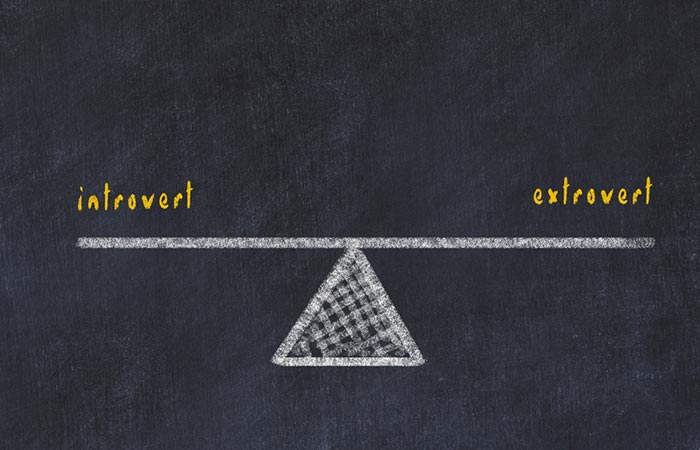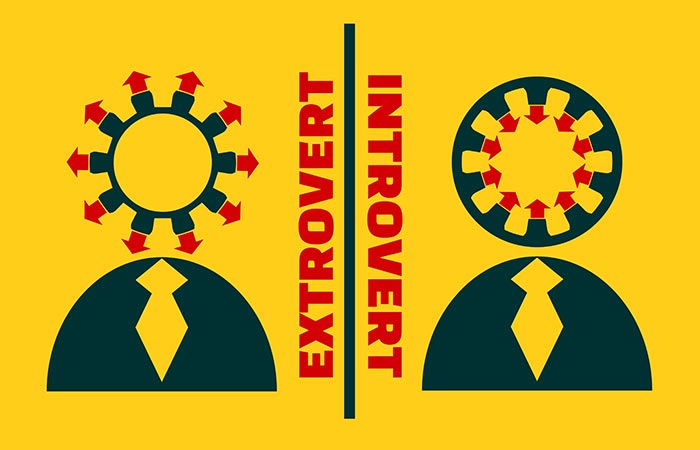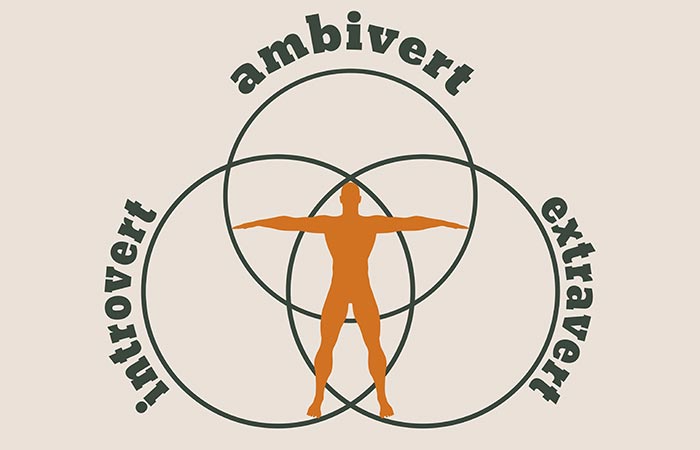Based on the nature of the different kinds of people, there are two types of personalities – introvert and extrovert. A person is generally considered an introvert if they are reserved and do not open up to others easily. On the other hand, when a person is talkative, social, and makes friends easily and quickly, they are considered an extrovert.
Introverts choose to remain isolated or prefer the company of a few close friends. Extroverts are outgoing and outspoken and enjoy talking and being around other people.
However, are all extroverts outgoing, and are all introverts shy? Not really. Understanding these personality types can help you manage your relationships with different kinds of people better.
To help you understand the true difference between introverts and extroverts, we have listed the general differences between the two. Take a peek!
What Is An Introvert?
A person who is solely interested in their own mental self is referred to as an introvert. People who are introverts are mostly reserved, most probably because they are preoccupied with their own feelings and thoughts. That’s why they need a lot of personal space and privacy.
Introverted people feel more comfortable and energized when they are left on their own. That is why they prefer solitary activities over social interaction. They prefer listening to music, reading, writing, etc. over partying and bar hopping. They have their private world of feelings, facts, and fantasies.
Many people believe that introverts are mostly shy and socially awkward. They are more of active listeners than speakers. They have a few close friends and do not make friends easily. However, their friendships are deep-rooted.
What Is An Extrovert?
Extroverts are those who love to interact with and be surrounded by other people. People who are extroverts are outspoken, socially confident, and gregarious. They love human interaction above almost everything else and thrive in social situations.
Extroverts focus on practical realities over inner feelings and opinions. They avoid solitude. They are way more informal, social, and enthusiastic than introverts. In addition, their communication skills are amazing. Individuals who have this type of personality enjoy social gatherings and parties and strive to become the center of attraction. They have the same attitude in public and private.
However, these two personality types are the very extremes on the scale. Most of us human beings fall somewhere in the middle of this spectrum. Introverts are of different types.
What Are The Different Types Of Introverts?
There are four kinds of introversion – social, thinking, anxious, and restrained. Many introverts are a combination of all four types. Let’s take a look at each:
- Social: Social introversion is the most accepted and understood type of introversion. Social introverts prefer socializing with small groups instead of hanging out with large ones. They can, sometimes, prefer no group at all. Those who have social introversion often prefer solitude. Social introverts love to stay in with a book or their lappy or stick to small gatherings with close family or friends. They avoid large parties with strangers like the plague. However, they don’t do this out of shyness or anxiety.
- Thinking: Thinking introverts don’t have the same aversion to social events or people. But they are thoughtful, introspective, and self-reflective. They are deep thinkers who prefer to take time out to think rather than party with people or carry out mindless activities for shallow entertainment.
- Anxious: Anxious introverts seek solitude because they are extremely shy and feel awkward and self-conscious around other people (especially strangers). They are not confident about their own social skills. Most often, their anxiety doesn’t disappear, even when they are all alone. Anxious introverts have a tendency to ruminate (to obsess over the things that may or already have gone wrong).
- Restrained: Restrained introverts operate at a slightly slower pace than other individuals. They generally think twice before they speak or act. They also may take some time to get going; they can’t just wake up and spring into action. They are slow and steady and are afraid of making a mistake in haste. That is why they may seem to take forever to do basic chores.
Just like introverts, even different types of extroverts exist.
What Are The Different Types Of Extroverts?
Extroverts are often known to be the life of the party. Their vibrant, outgoing nature draws other people to them, and they have a very hard time avoiding attention. They love interaction. Here are the different types of extroverts that exist:
- Extroverted Sensors (ES): Extroverted sensors love being stimulated by the information they sense from all around them. They use their five senses (sight, hear, taste, touch, and smell) to make sense of things and what is happening to them. They use these to understand the environment. Rather than being concerned about theorizing and hypothesizing, ES trust themselves and their own personal experiences. They prefer to be occupied with hands-on activities that provide intense physical stimulation (such as sports). Extroverted sensors are most often the greatest risk-takers and seek adventure. They have a tendency to get bored easily.
- Extroverted Intuitors (EN): Extroverted intuitors like focusing on the possibilities as well as delving into abstract ideas, rather than focusing on what is actually present. They are stimulated by deep, intellectual conversations and friendly debates in which they can discuss their viewpoints and exchange ideas with others. If ENs are bored or are feeling unfulfilled in stagnant conversations, they don’t have a problem moving on to a better source. Extroverted intuitors go to a party not for fun but because they are stimulated by the thought of what hasn’t happened yet or what could potentially happen.
- Extroverted Feelers: Extroverted feelers are extremely people-oriented. They love being around other people because it provides them the opportunity to learn from them as well as share their own experiences. Although extroverted feelers generally need to be alone some time to recharge, just like an introvert, they need the least amount of time to do so. Being around other people gives them fulfillment and a sense of purpose.
- Extroverted Thinkers: Extroverted thinkers are natural leaders with their confident and decisive nature. They focus on producing results and value logic and analytical thinking. They are goal-oriented individuals and are often over-achievers. They enjoy creating unique solutions for difficult problems and are driven by new challenges. Extroverted thinkers get recharged by climbing up the social ladder at every chance they get.
In the following section, we highlight the major ways introverts and extroverts differ from each other.
Difference Between Introverts And Extroverts
Common Introvert Traits
- Introverts enjoy spending time alone.
- Introverts are self-contained.
- Introverts don’t like to be the center of attention.
- Introverts value one-on-one relationships over group interactions.
- Introverts are more inward-focused.
- Introverts think before they speak.
- Introverts do not accept change easily.
- Introverts are not as talkative.
- Introverts need time alone to reflect and recharge.
- Introverts like to work in quiet, private, and independent environments.
- Introverts focus deeply on specific subjects.
- Introverts can concentrate deeply for long periods.
- Introverts can be considered reserved.
- Introverts have few quality friends. They focus on quality over quantity.
Common Extrovert Traits
- Extroverts tend to have large social networks.
- Extroverts like and enjoy being the center of attention.
- Extroverts tend to think out loud.
- Extroverts make quick decisions.
- Extroverts get recharged from being around other people and social interactions.
- Extroverts are enthusiastic, outgoing, and positive.
- Extroverts thrive in open and team-oriented work settings.
- Extroverts are gregarious in nature.
- Extroverts get easily distracted.
- Extroverts openly communicate about themselves with others, both known and unknown.
- Extroverts prefer to spend time with family and friends.
- Extroverts accept change easily.
- Extroverts are outward focused.
How To Become An Introvert?
Here are a few things you can do to become more of an introvert:
- Pursue solitary hobbies, such as painting, golf, gardening, playing an instrument, reading and writing, and hiking.
- Stay in on Friday/Saturday nights.
- Focus on personal relationships.
- Speak less.
- Pursue interests and a career that require lesser interactions. Writing and editing, court reporting, archival work, computer programming, research science, or library science are some examples.
- Make your living space cozy and comfortable.
- Focus on a single task at a time.
- Do a lot of in-depth thinking and research on projects.
- Take on solo responsibilities. Work alone.
How To Become An Extrovert?
- Value extroversion. Extroverts are often portrayed in a negative light as people who speak before they think. Not true. They have some great qualities. They make friends easily, are comfortable in crowds, and are the life of the party.
- Observe and learn from an extrovert you admire.
- Fake it until you make it.
- Start small. Take out 10 minutes of your day to be around people, and gradually increase the time.
- Hang around people. Even if you want to cancel plans, don’t.
- Do things for other people.
- Be a little unpredictable and wild.
- Join a club.
- Talk more.
- Attract attention. Speak up for yourself and others.
- Make people laugh and keep the party going.
The following section lists the traits of both introverts and extroverts.
Introvert Vs. Extrovert
“There is no such thing as a pure introvert or extrovert. Such a person would be in the lunatic asylum.” – Carl G. Jung
Recent research has shown that our genetic makeup has a lot to do with what personalities we have. It doesn’t matter how shy or outgoing we are, introversion and extroversion can actually be defined by where we derive our energy from (or how we recharge our minds).
Introverts tend to recharge by spending some private, quality time alone. They feel drained from being around people for a long period, particularly if the crowd is large. Extroverts gain energy from being around other people. They actually find that their energy and happiness is sapped when they spend too much time on their own, away from other people. They recharge by being super social, going to parties, hanging out with buddies every now and then, and spending time with family.
When it comes to talking, introverts tend to listen more than they speak. In fact, they think multiple times before speaking. Extroverts are the exact opposites. They speak their minds and seldom hold back on things.
Introverts detest change. They cannot easily adapt to new situations. On the other hand, extroverts accept change easily and even welcome them.
How The Brains Of Introverts And Extroverts Operate
As mentioned before, there is a vast difference in the brains of extroverts and introverts in terms of how they process rewards (1), (2). Also, their genetic makeup differs a great deal.
Extroverted brains respond very strongly when the gambles pay off. This was determined in an experiment that was conducted on people (3). A brain scanner found that when the gambles paid off, the extroverted group of people showed a stronger response in two brain regions, the amygdala and the nucleus accumbens.
The latter is part of the dopamine system. It affects how we learn things and is known for motivating us to look for rewards. Extroverts’ brains tend to push them towards taking risks, enjoying unfamiliar or surprising situations, and even seeking out novelty more than other people. The amygdala processes emotional stimuli, which, in fact, give extroverts that rush of anticipation and excitement when they try something stimulating (that may otherwise overwhelm an introvert).
This doesn’t happen with an introvert. They may not experience the same kind of excitement when undertaking something new or challenging. At a deeper level, an introvert may experience discomfort as well, though this doesn’t always have to be true.
Introverts also tend to notice all details, making them self-conscious about the mistakes they are committing. This usually means that they have a busy mind that is constantly thinking about what is going to happen.
There is also a difference in how introverts and extroverts tend to process stimuli. The stimulation is processed differently, depending on the type of your personality. Extroverts have a much shorter pathway. The stimulus runs through the area where touch, taste, and visual and auditory sensory processing takes place. In the case of introverts, the stimuli run through a long and complicated pathway in the areas of the brain associated with planning, remembering, and solving problems.
In addition to introverts and extroverts, there is another personality type that is as unique as it is interesting. They are the ambiverts.
Who Are Ambiverts?
Introverts and extroverts are extremes of the personality scale. Most people fall somewhere in the middle. Most of us tend to lean one way or the other, but there are some people who are quite balanced and have a bit of both personality traits. These people are called ambiverts.
Ambivert people exhibit both introverted and extroverted tendencies. They generally love being around people, but after a decent period, this begins to drain them. Also, they enjoy solitude and quiet, but not for a long time. Ambiverts recharge their minds with a balanced mixture of social interaction and quality alone time. Though ambiverts may seem to be the most boring personality type between the three, their balanced nature could actually be a blessing.
With this guide, you will now be able to identify these two personality types. It is great to have both kinds of friends because you will get to learn so much from them. However, if you tend to lean towards one end of the spectrum, you can try incorporating a few traits of the opposite personality type so that you can enjoy life a little bit more.
Are you an extrovert or an introvert? Let us know in the comments section below – yes, you too introverts! We would love to hear from you!
3 sources
- Brain Activity Differs In Introverts And Extroverts, UI Study Shows, American Association for the Advancement of Science (AAAS).
https://www.eurekalert.org/pub_releases/1999-03/UoI-BADI-290399.php - Extroverts have more sensitive brain-reward system, Cornell Chronicle, Cornell University.
https://news.cornell.edu/stories/2013/07/brain-chemistry-plays-role-extroverts - Individual differences in extraversion and dopamine genetics predict neural reward responses, Cognitive Brain Research, Elsevier, ScienceDirect.
https://www.sciencedirect.com/science/article/abs/pii/S0926641005002880
The post Introvert Vs. Extrovert: Differentiating Between The Two Personality Types appeared first on STYLECRAZE.





0 Comments